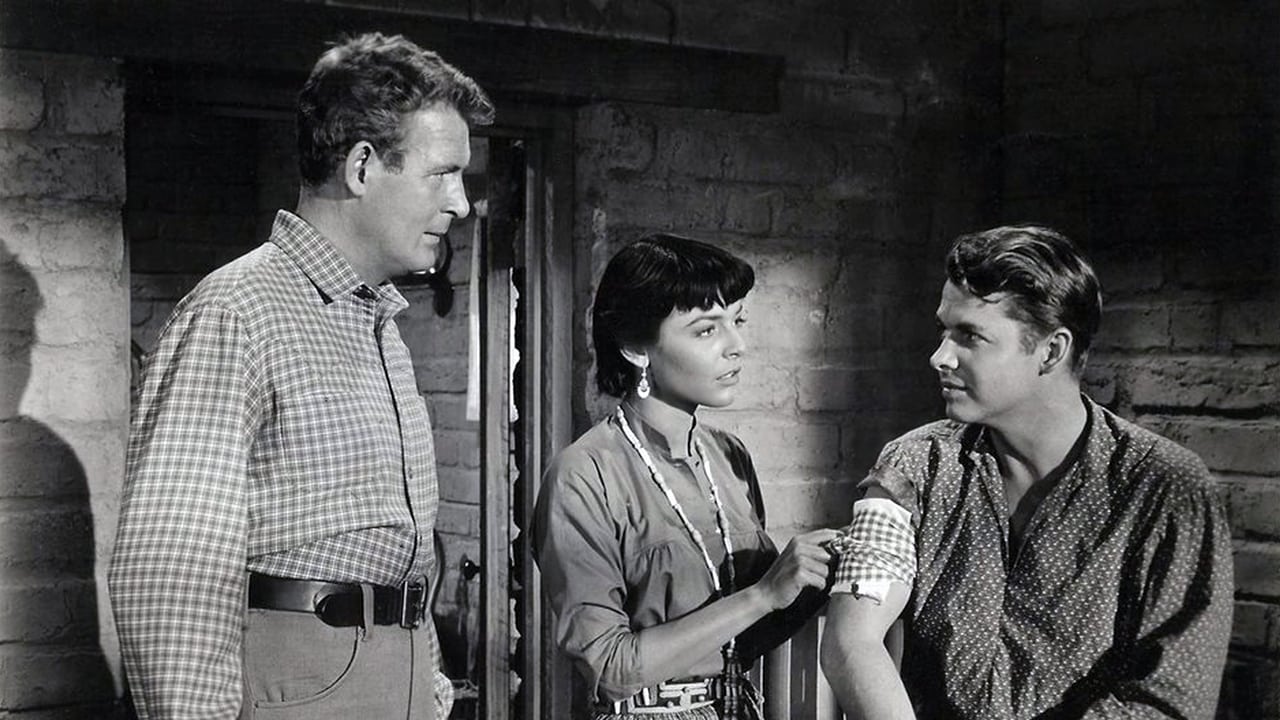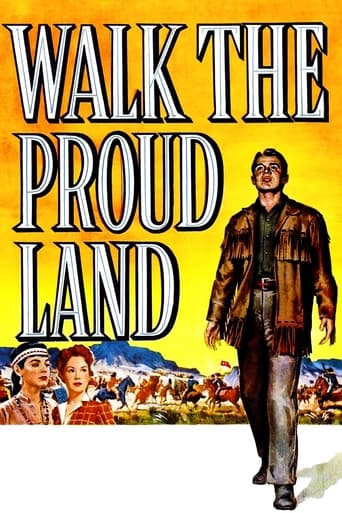

Masterful Movie
... View MoreI gave it a 7.5 out of 10
... View MoreA lot of fun.
... View MoreThis is one of the best movies I’ve seen in a very long time. You have to go and see this on the big screen.
... View MoreCopyright 1956 by Universal. New York opening at the Palace: 7 September 1956. U.S. release: 1 September 1956. U.K. release: 3 September 1956. Australian release: 1 November 1956. Sydney opening on a double bill at the Capitol (ran one week). 7,925 feet. 88 minutes.SYNOPSIS: John Philip Clum is appointed Indian Agent at the San Carlos Apache Reservation, where he finds the Army using violent means to suppress the Indians. Clum asserts his authority to help the Apaches, thus earning the displeasure of the people of Tucson. In gratitude, the Indians send Tianay to keep house for him. This arouses the jealousy of Clum's fiancée, Mary Dennison. COMMENT: In the present=day climate of racial tolerance, integration and understanding, it's a big surprise that this screen biography of a true-life Indian agent who blazed this particular trail, is not constantly revived. Admittedly, next to its patent earnestness, the picture's main virtue is its expansive CinemaScope location cinematography. However, regard for a movie's artistic scope has never stopped TV managers dead in their tracks before. So why now? Maybe the film lacks excitement. That it does, though those who decry Hollywood for distorting reality will certainly have cause to rejoice in this exception. No doubt the nagging wife is pretty close to the essence of what really happened too.It's a pity that the direction of this worthy script should be so flatly pedestrian. Less than talented directors like Jesse Hibbs (former football star) welcomed CinemaScope because it relieved them of the burden of having to think in terms of visual excitement. Now simply the scope itself is the thing. No dramatic compositions, no effective cutting, no pointed camera movement necessary. No need to draw fine performances either, because for most of the time the actors are lost in the landscape. When studio scenes take over, why that's a good time for patrons to duck out to the candy bar. Unless of course you're such a rabid fan of Audie Murphy, you don't care a fig what long speeches he gets off his chest, or how stiffly he stands, just so long as his magnified pudgy face is right up there in front of you!
... View Moreit is its basic virtue. for theme and for its inspired manner to present as biopic. for acting and for the mixture of innocence, courage, force and beautiful images. for realism and for Audie Murphy performance. a film about the image and the essence of relationship and about a form of heroism who has not ordinaries rules. a classic western. and more because it is not an idyllic picture about Far West but body for a noble message who preserves the measure at high level. touching and convincing, it has a special note of melancholy and poetic message. a film. real good. a homage. like remember source about the respect for the other, out of ordinary tolerance.
... View MoreWalk the Proud Land is directed by Jesse Hibbs and adapted to screenplay by Gil Doud and Jack Sher from the biography of John Philip Clum, Apache Agent, written by his son Woodworth Clum. It stars Audie Murphy, Anne Bancroft, Pat Crowley, Charles Drake, Tommy Rall and Robert Warwick. A Technicolor/CinemaScope production out of UIP, music is supervised by Joseph Gershenson and cinematography by Harold Lipstein.1874, San Carlos, Arizona, and John Philip Clum (Murphy) arrives and attempts to broker peace with the Apache by way of letting them have autonomy away from army government.Don't turn your back on him. No matter what it says in the Bible.Colourful character driven Western that's based on a real Indian agent, it portrays his determination and faith to get the Apache to agree to peace whilst affording them dignity and honesty. As everyone who as seen it will attest, this is no action packed Audie Murphy Oater, but although it was met with indifference at the box office and by Western critics, film is never less than enjoyable or interesting. John Clum is a peaceable man, a humanitarian, film's strength lies in his driven will to succeed against many odds. Bigotry and stubbornness surrounds him, but his approach is infectious and as a man his efforts laid a firm foundation for a bit of history to be made. Not least that he was the man who captured Geronimo (here played by Jay Silverheels) without a shot being fired in anger. He was a man worthy of a film, and even though this is obviously condensed down and dressed up for Hollywood, it's worth watching to catch the essence of a special type of man, a man splendidly essayed by Audie Murphy. Harold Lipstein captures some beautiful Old Tucson scenery to add evocative flavours, and Hibbs' direction is unobtrusive.A domestic problem played out in the plot is a touch too saggy, and nearly pointless, and the all too familiar problem of white actors playing lead Native Americans is all too evident. But this is a very tidy production with a very worthwhile story being told. 7/10
... View MoreThe narrative of John P. Clum's broadly varied activities is one of the most dramatic in U.S. history, his tenure as Indian Agent at Arizona's San Carlos Reservation, 1874/77, being particularly noteworthy and forming the subject of this film starring war hero Audie Murphy as Clum. During his assignment to San Carlos, Clum established the first Indian tribal police and court system, using the former to capture the wily Geronimo, convincing the renegade that he was surrounded by a large group of warriors, far from the case. By accomplishing all of this and more, Clum eliminated any possible requirement for continued deployment of a United States Army cavalry regiment at San Carlos, which erased profits from provisioning for the Army and made Clum's presence less than heaven-sent for the mounted troopers. WALK THE PROUD LAND is based upon incidents to be found within Woodworth Clum's 1936 biography of his father, which is the principal source for the screenplay written by the capable pair of Gil Doud and Jack Sher. Unfortunately, Doud ("To Hell and Back") and Sher ("Shane") fail to utilize the most dramatic elements of Clum's story, replacing them with a collection of banal contrivances which serve only to dissipate the feature's impact. Filmed with the wide-screen Cinemascope process, and with sublime Technicolor, the work is delightful to the eye, and benefits as well from the stylish efforts of costumer Bill Thomas. A top-notch performance is given by Anne Bancroft as an Apache warrior's widow who is "given" by the tribe's chief to Clum and who becomes his strongest ally against the Agent's enemies from within both the cavalry and the tribe. Audie Murphy's native earnestness is very effective in his portrayal of Clum, with his palpable lack of emotive flexibility being of no consideration here, and he is well supported by Bancroft, sturdy Charles Drake as his closest comrade, winsome Pat Crowley as his wife, Tommy Rall as his Indian blood brother, and character actors Addison Richards and Morris Ankrum. Many good hands were not utilized properly during the creation of this film, and since Clum's travails were largely for nought, Geronimo being released by his successor, leading to nearly 15 years of unabated Indian wars, a bittersweet and indeed revelatory quality would have been more effective in lieu of numerous scenes depicting lamely comedic children and romantic frippery that have no basis in fact.
... View More